Snowmobile History: Big Money Players

The golden era of snowmobiling had its share of big money owners
When we review the financial statements of today’s snowmobile manufacturers, we appreciate how hard they work to generate profits. Despite what many politicians would have you believe, it’s not all huge salaries, private jets and lush lifestyles in the real world of day-to-day businesses. Frankly, politicians probably have it easier than most corporate executives. Take a look back at how much money there was invested in snowmobiling in 1972 compared to 2012.
In today’s real world of snowmobile financials, three of the four sled companies file annual reports, although one — Yamaha — does it on the Tokyo exchange and not Wall Street. Bombardier Recreational Products, being privately held in a three-some of Bain Capital (50 percent ownership), the Bombardier Family (35 percent) and Caisse de depot et Placement du Quebec, the second largest pension fund in Canada (15 percent) does not have to file a public annual report. The company claims annual revenues of more than $2 billion. That compares to Arctic Cat, which listed revenues of $585 million dollars for the most recent reporting period. Polaris showed $2.6 billion on its fact sheet, while Japan-based Yamaha led the parade with $16.1 billion dollars in reported revenues for last year. Of course, not all of that relates to their snowmobile market share positioning. But it is interesting to note that Yamaha is more than six times larger than the next biggest player in the sled biz.
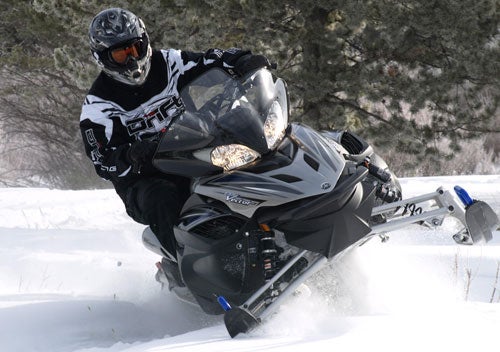 While Yamaha may hold fourth-place in 2012 snowmobile market share, the parent company enjoys a substantial advantage based on corporate revenues.
While Yamaha may hold fourth-place in 2012 snowmobile market share, the parent company enjoys a substantial advantage based on corporate revenues.While we can look at those numbers and think we have a feel of how big the modern day snowmobile business is, don’t! In 1972 there were some truly big money players involved. Perhaps part of the reason they were big monied entities is because they knew how to cut their losses. Of the 20 or more snowmobile companies producing sleds in the 1970s, only Yamaha, Polaris, Arctic Cat and Ski-Doo remain. If you look at these four companies, you see some interesting historical data.
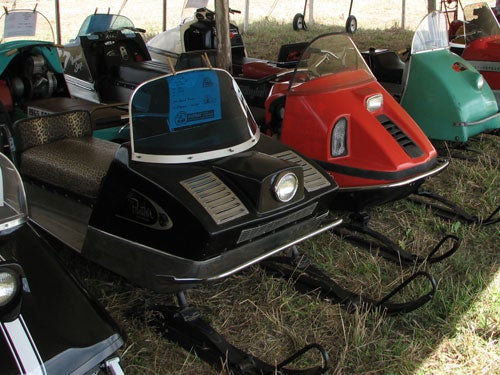 Many sled brands, even though they appeared to have substantial corporate resources at the time, never made it into the 21st century.
Many sled brands, even though they appeared to have substantial corporate resources at the time, never made it into the 21st century.In 1972 Arctic Cat, which was never bought out by a large multinational company, was building a reputation that would allow it to be the only snowmobile brand to ever go out of business and successfully come back. The Thief River Falls, Minnn. company generated sales of about $125 million in 1972. Carry that forward and you see a firm that would account for $531 million in today’s dollars. We’re not sure how you relate this, but in the 40 years that have passed, Arctic Cat revenues are about the same now ($585 million) as they were then ($531 million).
Yamaha has done much better. In 1972 the company was just getting into the sled business and had corporate revenues of $455 million, which would be about $1.9 billion in today’s calculations. But, Yamaha has done much better worldwide as it reported 2011 revenues of more than $16 billion. Nice work!
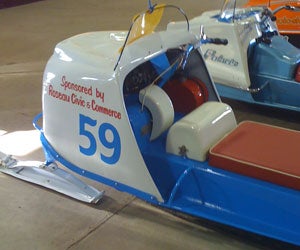 Polaris is the only sled maker to have been bought by a huge multinational conglomerate (Textron) in the 1970s and lived to tell about it into the next century.
Polaris is the only sled maker to have been bought by a huge multinational conglomerate (Textron) in the 1970s and lived to tell about it into the next century.Even though Ski-Doo doesn’t float its financials publicly, based on BRP’s claimed revenues of $2 billion-plus, that’s better than its 1972 sales updated to 2012 dollars. Back then, Ski-Doo accounted for $107 million in sales, which would be about $450 million in modern cash equivalents. So, BRP is doing four times better.
Polaris was the only one of the current four sled manufacturers to have been owned by a multinational corporation back in 1972. As part of Textron, Polaris Industries saw its headquarters moved from Roseau, Minn. to Minneapolis, although manufacturing stayed in the company’s hometown. Textron was a global partner offering Polaris increased manufacturing in Roseau of E-Z-Go golf carts. Of course, the golf cart business was just one of Textron’s sidelights. The corporation also listed Bell helicopters in its portfolio as well as Sheaffer pens among others. At the time Textron was a $678 million outfit, one of the biggest players in the game.
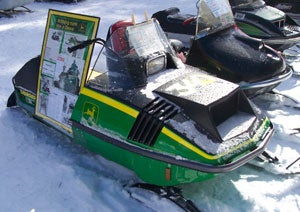 Even with the deep financial pockets of agri-giant John Deere, this brand dropped out in the mid-1980s and models like this Liquidator have become valuable collector’s items.
Even with the deep financial pockets of agri-giant John Deere, this brand dropped out in the mid-1980s and models like this Liquidator have become valuable collector’s items.And, while Textron was big, there were other snowmobile corporate parents with big wallets. Agricultural giants John Deere and Massey-Ferguson sometimes used their lines of snowmobiles as “throwaway” enticements to their largest snow country-based farmers to keep them buying those very profitable combines and harvesters. In the early 1970s, John Deere offered a selection of sleds that followed the design successfully championed by Ski-Doo. While Massey-Ferguson’s $190 million dollar size was only a fifth of John Deere’s, the company used its snowmobiles to create a uniquely styled series of Ski-Whiz sleds that looked more yard tractor than sporty trail sled.
ARCMCO Steel’s $910 million size included the Chaparral brand of snowmobiles. Despite its more than 1200 dealers across the snowbelt and its truly nifty SSX liquid-cool engined entry, the Denver-based ARMCO Recreational Products subsidiary dropped all sleds before winter snows hit in the 1974-1975 season.
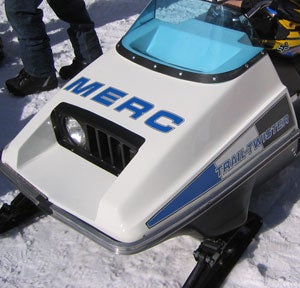 Although Brunswick Corporation dropped out of the snowmobile business; its Mercury brand remains strong in boat engines.
Although Brunswick Corporation dropped out of the snowmobile business; its Mercury brand remains strong in boat engines.Money didn’t seem to be the deciding factor in which companies stayed and which ones fell by the side. Or, then, maybe it was. With an oil crisis looming and tough economic times forecast as the Vietnam War began to come to a halt, big companies looked at their line items for cutbacks. With no emotional attachment to snowmobiling, which many companies saw as seasonal and regional, companies found their sled lines easy to cut.
Harley-Davidson snowmobiles, which got to the snow under the AMF umbrella, listed itself as a very small portion of the $924 million revenue picture in 1972. Likewise, Brunswick with annual revenues of $633 million would stay with its Mercury line of snowmobiles for a while, but not at the expense of its Mercury Marine boat engines and Brunswick bowling centers.
Evinrude, as part of Outboard Marine Corporation (OMC), established itself as the “quiet” snowmobile and experimented with rotary sled engines. But OMC shut the door on $17 million in snowmobile sales and used it for other ventures to keep the $400 million corporation in boats and motors. Ironically, Evinrude is part of the BRP family and again leads in engine technologies with its E-TEC direct injection for two-stroke motors.
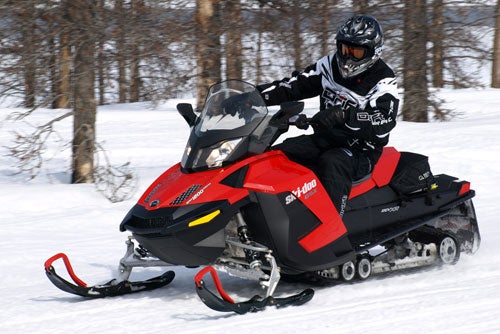 BRP, Ski-Doo’s privately-held corporate parent, brought E-TEC technologies over from its acquisition of OMC’s Evinrude brand, which was once the world’s largest outboard motor manufacturer.
BRP, Ski-Doo’s privately-held corporate parent, brought E-TEC technologies over from its acquisition of OMC’s Evinrude brand, which was once the world’s largest outboard motor manufacturer.Back in 1972 there were some very heavy hitters with lots of financial backbone participating in the snowmobile industry. Alouette was owned by toy maker Coleco. The $434 million Fuqua Industries oversaw Scorpion snowmobiles. The Coleman Company operated the redesigned Skiroule snowmobile group as part of its $134 million portfolio of companies. And, yes, today’s largest snowmobile parent company, Yamaha, even had a serious Japanese competitor. Financially stronger than Yamaha with $588 million in annual revenues, Suzuki came to the sled business about the same time as Yamaha’s entry. But after a time, rather than build complete sleds, Suzuki stayed in the snowmobile industry as the engine partner of Arctic Cat until recently.
It is interesting to look at today’s survivors. Although Polaris had the parent with the deepest pockets, the Roseau pioneer faced its own tough times when Textron abandoned the sport. When you look at who’s left and how they managed to survive, it’s obvious that money didn’t really matter all that much as none of the big-money players stayed in the sport for the long haul. The four that remain — Arctic Cat, Polaris, Ski-Doo and Yamaha — might not have been the ones you’d have bet on in 1972, but in 2012 we’re glad they made it.
| Revenue Rankings Today | |
| How the parent companies of today’s four snowmobile manufacturers ranked in overall reported corporate revenues for 2011: | |
| Yamaha | $16 Billion (Publicly traded on the Tokyo stock exchange.) |
| Polaris | $2.6 Billion (Publicly traded on the New York stock exchange.) |
| BRP/Ski-Doo | $2 Billion in claimed revenues (BRP as a privately held corporation is not required to publicly report earnings.) |
| Arctic Cat | $585 Million (Publicly traded on the NASDAQ.) |
| Revenue Rankings in 1972 | |
| How the parent companies of today’s four snowmobile manufacturers ranked in overall reported corporate revenues for 2011: | |
| Chaparral | Parent company: Armco Steel – $910 Million in 1972. (NOTE: ARMCO Steel evolved into AK Steel and reported 2011 revenues of $6.4 billion.) |
| Polaris | Parent company: Textron – $678 Million in 1972. (NOTE: Textron reported 2011 revenues of $11.2 billion.) |
| Mercury | Parent company: Brunswick Corporation – $633 Million in 1972. (NOTE: Brunswick’s Mercury Marine group is one of the world’s largest manufacturers of outboard motors. Brunswick reported 2011 revenues of $3.7 billion.) |
| John Deere | Parent company: John Deere – $500 Million in 1972. (NOTE: John Deere reported 2011 revenues of $29.5 billion.) |
| Evinrude and Johnson | Parent company: Outboard Marine Corporation – $400 Million in 1972. (NOTE: OMC, once the world’s largest maker of outboard motors, went into bankruptcy in 2000 and saw its Evinrude & Johnson motors become part of Bombardier Recreational Products in February 2001.) |
Related Reading Snowmobile Sales Leaders Through the Years Polaris and Arctic Cat: A Snowmobile Success Story How Ski-Doo Changed Snowmobiling in 2003 50 Years of Arctic Cat



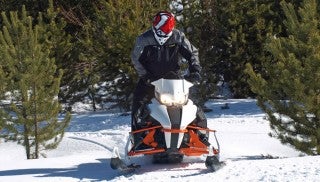




 Your Privacy Choices
Your Privacy Choices